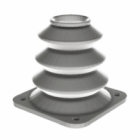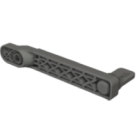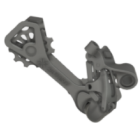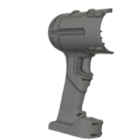3D printing waste
While 3D printing is known for its material efficiency, it’s not entirely waste-free. From failed parts to leftover support structures and post-processing debris, waste is an inevitable byproduct of any additive workflow. Managing it well is key to building a responsible and repeatable process — especially as print volumes scale.
Types of waste in 3D printing
Waste in 3D printing comes in multiple forms, many of which are less visible than traditional production scrap:
- failed or rejected parts – caused by print errors, poor adhesion, or incorrect settings,
- support structures – necessary for overhangs but often not reusable,
- brims, rafts, and skirts – discarded after printing,
- leftover resin or powder – partially cured or contaminated material,
- post-processing byproducts – sanding dust, chemical solvents, IPA, used gloves, or wipes.
The volume and type of waste depend heavily on the printing method — which makes waste analysis a technology-specific task.
Managing 3D print waste responsibly
Disposing of 3D printing waste isn’t as simple as tossing it in the bin. Even if the volume seems small, repeated prints quickly generate measurable byproducts. PLA and PETG may be recyclable in some regions, but only if clean and sorted. Resin-contaminated tools and failed prints, on the other hand, often count as hazardous waste and must be treated accordingly.
The best approach starts with planning: separating waste by type, labeling containers clearly, and checking local disposal options before you even start printing. If you’re working with resin or powders, secure containment and proper ventilation are essential — not just for sustainability, but for safety.
The case of SLS powder reuse
SLS printing presents a unique opportunity — and a challenge — when it comes to waste. Since the unused powder in each build isn’t fused, it can be collected and reused in future jobs. But not all of it retains its original performance. After several heating cycles, the powder begins to degrade: it flows less easily, bonds less cleanly, and may introduce print defects.
To counter this, most SLS workflows include a powder “refresh rate,” where a percentage of fresh material is added with every reuse. With good storage, sieving, and part packing practices, some operations can reuse over 70% of their powder per cycle. Still, what remains unused eventually becomes waste — unless it’s processed through advanced closed-loop systems.
Designing with waste reduction in mind
Preventing waste is better than managing it. Many of the most effective waste-reduction strategies begin not at the printer, but on the screen — during the design phase. Thoughtful orientation can reduce the need for supports. Combining parts into a single geometry minimizes assembly and overproduction. Testing prototypes using draft modes or simulation tools avoids physical trial-and-error.
Even subtle tweaks to geometry or settings can have a big downstream impact on how much plastic, powder, or solvent ends up discarded.
Final thought
Waste in 3D printing is manageable — but only when you understand where it comes from and make it part of your planning. Whether you’re running a desktop FDM setup or an industrial SLS system, the key is to view waste not just as an inconvenience, but as a measurable part of the process you can improve.
Explore also
- Is 3D printing sustainable?
- Is 3D printing bad for the environment?
- 3D print recycling
- Sustainable 3D printing materials
- 3D printing environmental impact
Related categories
 Austria
Austria  Bosnia and Herzegovina
Bosnia and Herzegovina  Bulgaria
Bulgaria  Croatia
Croatia  Czech Republic
Czech Republic  Denmark
Denmark  Estonia
Estonia  Finland
Finland  France
France  Germany
Germany  Greece
Greece  Hungary
Hungary  Ireland
Ireland  Italy
Italy  Latvia
Latvia  Lithuania
Lithuania  Poland
Poland  Portugal
Portugal  Romania
Romania  Slovakia
Slovakia  Slovenia
Slovenia  Spain
Spain  Sweden
Sweden  Switzerland
Switzerland  United Kingdom
United Kingdom  Ukraine
Ukraine  China
China  Hong Kong
Hong Kong  India
India  Israel
Israel  Japan
Japan  Malaysia
Malaysia  Philippines
Philippines  Saudi Arabia
Saudi Arabia  South Korea
South Korea  Taiwan
Taiwan  Thailand
Thailand  Turkey
Turkey  United Arab Emirates
United Arab Emirates  Egypt
Egypt  South Africa
South Africa  Tunisia
Tunisia  Canada
Canada  Mexico
Mexico  United States
United States  Brasil
Brasil  Colombia
Colombia  Australia
Australia  New Zealand
New Zealand 












